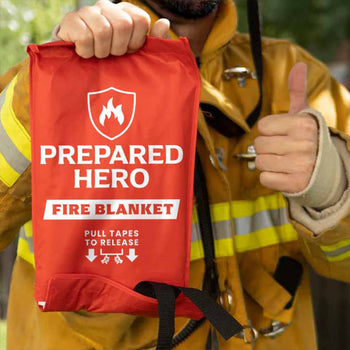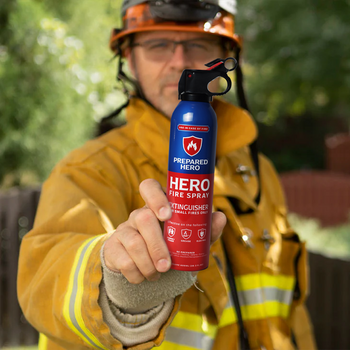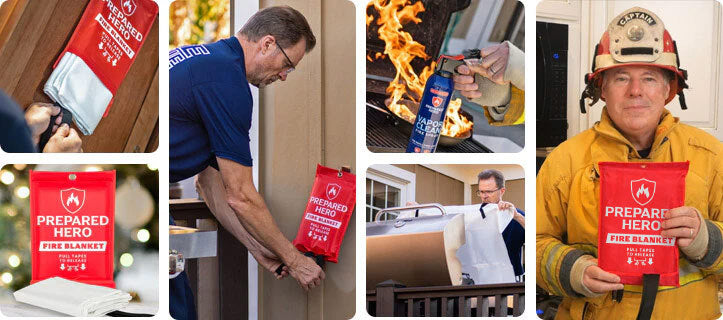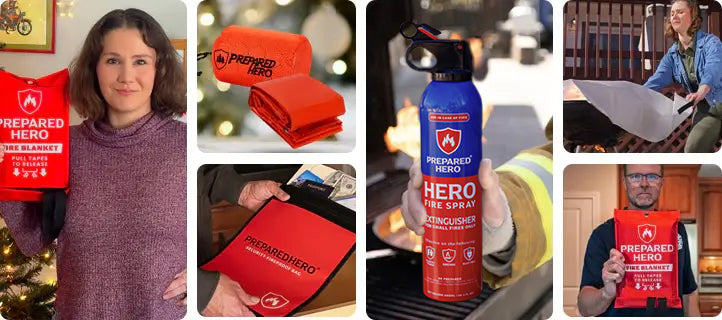Where you put your smoke detectors matters just as much as installing them. Proper placement makes sure they can detect...
Class A fires are the most common type of fire. They can occur at home, in offices, outdoors, and even in vehicles. But what exactly are Class A fires? What fuels them? How can you prevent one from occurring?
In this article, we’ll talk about Class A fires, what causes them, and where they usually happen. We’ll also go over how to prevent and put them out.
What Are Class A Fires?

Class A fires are a type of fire that involves ordinary combustibles. These are items commonly found around homes and offices. Common combustibles include wood, paper, plastic, and fabric.
Class A fires can start in many ways, including everyday activities. For instance, having clutter at home can start a Class A fire. Think about the piles of magazines, storage boxes, or clothes lying around. A Class A fire can occur if a candle tips over or a spark from an outlet lands on the said piles.
Weather changes also contribute to the occurrence of Class A fires. During dry months, leaves and grass can catch fire quickly, especially if people throw burning cigarettes or matches on the ground.
Contrary to popular belief, Class A fires are dangerous. For one, they can spread quickly, especially if there are many flammable items around. Once the fire starts, it can quickly consume nearby furniture, drapes, and decor. The smoke from Class A fires can also be toxic and quickly fill a room. This poses a risk to anyone inside the house or building.
Class A fires usually occur in homes. For instance, a fireplace embers landed on an old couch with a fabric cover. The fabric catches fire, which can quickly spread to the throw pillow, curtains, and wall outlets.
Another example of a Class A fire is a campfire that ignites dry leaves, grass, or wood near it. The fire then spreads to the rest of the campsite, devouring everything in its way. This is why it’s important to put out campfires properly, especially during summer.
Common Causes of Class A Fires

Causes of Class A fires can be found in homes, offices, outdoors, and vehicles. Knowing what fuels Class A fires lets you take proactive steps to minimize risks. Here are the top causes of Class A fires:
1. Wood
Wood is everywhere— from your furniture to the beams in your house. It is naturally combustible, so it can start a fire if exposed to flame or heat source. For instance, if a candle knocks over your wooden coffee table, the table can ignite and spread flames throughout your living room.
2. Paper
Paper is another common cause of Class A fires. We’re talking about newspapers, magazines, books, documents, and paper towels. Paper has a low ignition temperature, so it doesn’t need much heat to start burning. For instance, documents on your nightstand can start a Class A fire if exposed to an overheating lamp.
3. Fabric
Fabrics like clothes, drapes, rags, towels, and bed sheets can also cause Class A fires. While not as combustible as paper, fabric can catch fire from a spark or heat. For example, leaving a cleaning rag near a stove with open flames can start a fire.
4. Plastics
Common household items made from plastics, such as toys, containers, decor, and packaging, can fuel a Class A fire if they come into contact with a heat source. Plastics burn easily and produce poisonous gases. Imagine a plastic toy left too close to a space heater that overheats.
5. Cardboard
Cardboard is used for packaging and storage, making it common in homes. These boxes are highly flammable and can ignite with a small flame. For example, if you stack cardboard boxes in your garage beside a malfunctioning heater, the boxes will start a Class A fire.
6. Furniture
Furniture is often made of wood and fabric, making it a top fuel for Class A fires. If a piece of furniture catches fire, it can rapidly spread because wood and fabric are common fuels. For instance, if a burning candle trips onto a bed, the bed can ignite quickly and start a Class A fire.
7. Dryer Lint
Lint accumulates in your dryer and is highly flammable. If you don’t clean your dryer regularly, the lint can ignite. For example, if your dryer overheats, the lint buildup can catch fire.
8. Dry Vegetation
Dry grass, leaves, branches, and other vegetation can quickly catch fire, especially if the weather’s hot. For instance, carelessly throwing a burning cigarette on a pile of dry leaves can start a Class A fire.
Where Do Class A Fires Happen?

Class A fires can happen just about anywhere, but there are specific locations where they’re more likely to occur. Here are the most common places where Class A fires start:
Homes
Houses are one of the most common spots for Class A fires. You see, houses are filled with fire hazards that can quickly ignite. Think about living rooms filled with couches, wooden tables, and plastic decor. Paper products, including newspapers, magazines, and mail, are also found in homes.
Kitchens are another hotspot, with everyday items like paper towels, cleaning rags, and food packaging that can easily catch fire. If they get near a lit gas stove or malfunctioning oven, a Class A fire can start.
Bedrooms are also at risk because of the curtains, bedding, and clothes in them. A small candle left unattended or a space heater too close to the bed can easily trigger a Class A fire. Additionally, garages or workshops are dangerous because they contain flammable materials like sawdust and boxes.
Outdoor Areas
Outdoor areas are also prone to Class A fires. When the weather’s hot and dry, grass, leaves, and other vegetation become more combustible. Careless acts, such as tossing a lit match on the ground or leaving a fire pit unattended can lead to a Class A fire.
Parks and forests are vulnerable to this since embers from a campfire or a discarded match can ignite a pile of fallen leaves, turning a small flame into a raging inferno in no time.
Workplaces
Class A fires also occur in workplaces, especially in factories and warehouses. These places contain wooden pallets, plastics, and cardboard boxes―common causes of Class A fires. On the flip side, paper products like documents and packaging in offices can ignite fires, especially if there are overloaded outlets or frayed wires.
Vehicles
Not many people realize this, but Class A fires can occur in vehicles, too. The upholstery, plastic dashboard, and personal items in your car can easily ignite because it’s hot or your engine overheated. For example, leaving a window lets sunlight focus on the documents inside, which can lead to a fire.
How to Put Out Class A Fires

Quick action can stop Class A fires from spreading and causing serious damage and injuries. Understanding how to put out Class A fires keeps your family safe. Check out how to do it below:
1. Don’t Panic
You should stay calm when dealing with a Class A fire. Panicking can lead to poor decisions that put you and others at risk. Take a moment to assess the situation before acting. If the fire is small and manageable, you might be able to put it out. If it’s spreading quickly or you feel unsafe, evacuate the area immediately and call for help. Find out when to evacuate your house after a fire starts here.
2. Use a Fire Blanket
Another effective way to smother a small Class A fire is using a fire blanket. Fire blankets are made from fire-resistant materials that can withstand high temperatures.
Plus, they’re easy to use. Simply unfold the blanket and place it over the fire. Doing this cuts off the oxygen supply and extinguishes the flames. They’re especially useful in kitchens, where small fires can break out around stoves.
3. Use a Fire Spray
Another handy tool for putting out Class A fires is a fire spray. Fire sprays can extinguish flames quickly. Plus, they’re non-toxic, more lightweight, and easier to use than a traditional extinguisher. Just aim the nozzle at the base of the fire and spray from side to side.
4. Use a Fire Extinguisher
If the fire is manageable and you have a Class A fire extinguisher, now’s the time to use it. Stand a safe distance away and remember the PASS fire extinguisher technique: pull the safety pin, aim the nozzle at the base of the fire, squeeze the handle, and sweep from side to side.
5. Check for Hot Spots
Look for hot spots once the fire is out. They might reignite and cause another disaster. Make sure everything is completely cool before leaving the affected area. By being thorough in your checks, you can help prevent another fire from starting.
6. Clear the Area
If you don’t have the tools mentioned above, the fire is getting out of control, or you feel unsafe, get out right away. Close doors and windows behind you if possible. Doing this helps contain the fire and prevent it from spreading to other areas. Don’t try to get your belongings; your safety is the priority here.
7. Call for Help
Call 911 or your local fire department and provide them with clear information about your location and the nature of the fire. They’re trained to handle fires safely.
How to Prevent Class A Fires

Knowing how to prevent Class A fires—like keeping flammable materials far from heat sources and not overloading outlets—you can stop fires from causing damage. Here’s how to do it:
1. Keep Spaces Clean and Organized
One of the easiest ways to prevent Class A fires is to keep a clean and organized environment. Regularly clean up paper, cardboard, and plastic items that can easily ignite. You should also have designated storage areas for paper items and avoid stacking them near heat sources.
2. Store Flammable Materials Safely
Flammable materials like wood, paper, and fabrics should be stored away from heat sources. Store items like firewood, newspapers, and rags in a cool, dry place, preferably in a garage or shed. Make sure that your storage areas are well-ventilated and not overly cluttered.
3. Use Ashtrays and Trash Cans Properly
Always use ashtrays and never throw cigarette butts in the trash unless they’re completely extinguished. Similarly, make sure your trash cans are made of metal so they won’t ignite as easily as plastic ones.
4. Install Smoke Alarms
Installing smoke alarms at your home and office is a key fire safety measure. Smoke alarms can provide early warnings and give you enough time to respond or evacuate. Make sure they’re working correctly by testing them. Find out how often to test your smoke alarms here.
5. Educate Everyone
Make sure that everyone in your house or workplace knows about fire safety and prevention. Discuss the dangers of flammable materials and what to do in case of a fire. Regular fire drills at home and work also ensure everyone knows what to do during a fire emergency.
Conclusion
Understanding Class A fires and knowing how to prevent and put them out keep homes and workplaces safe. By being proactive—like cleaning clutter and storing flammable items away from heat sources—you reduce fire risks.
Having fire safety tools, such as fire blankets and fire sprays, is equally important because they can quickly smother small fires before they escalate. So, whether you’re at home, work, or out and about, being prepared makes a big difference.
Do you want reliable, easy-to-use, and non-toxic tools that can help you put out Class A fires quickly? Check out Prepared Hero’s fire safety tools here, and get up to 51% off on certain items. Stay safe, hero!


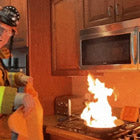 Fire
Fire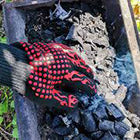 Safety
Safety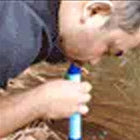 Survival
Survival Protection
Protection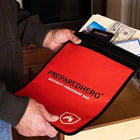 New
New
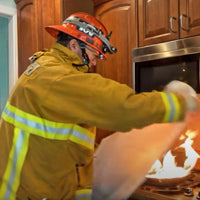 Fire
Fire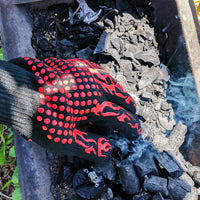 Safety
Safety Survival
Survival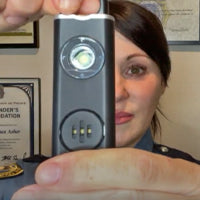 Protection
Protection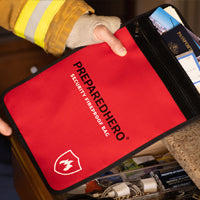 New
New
